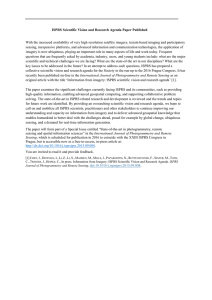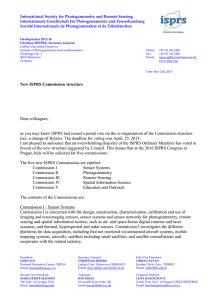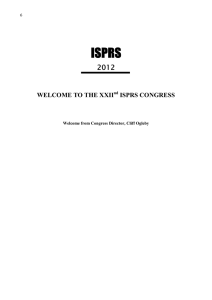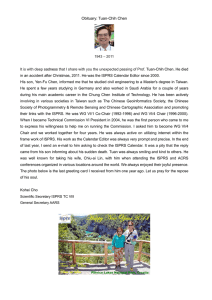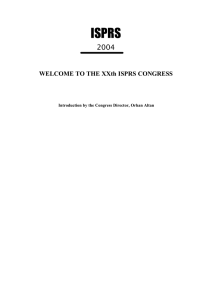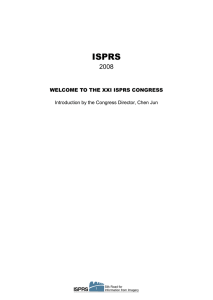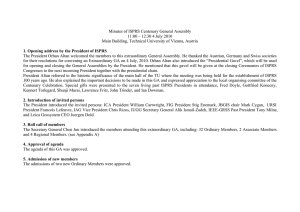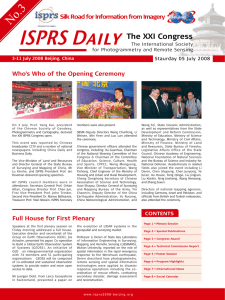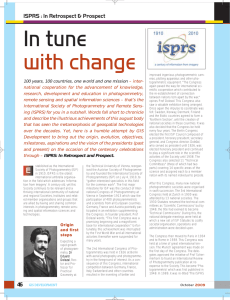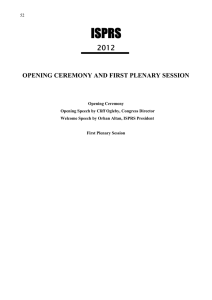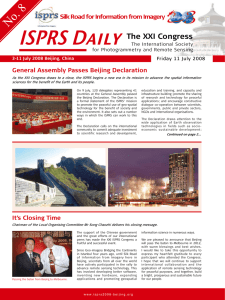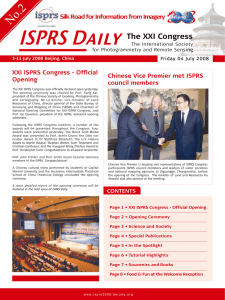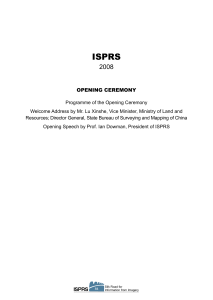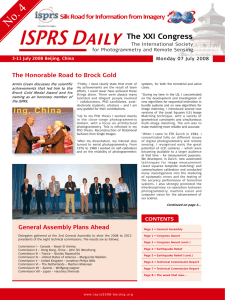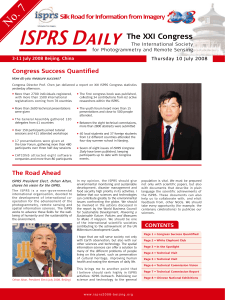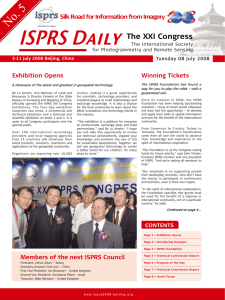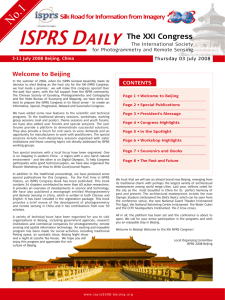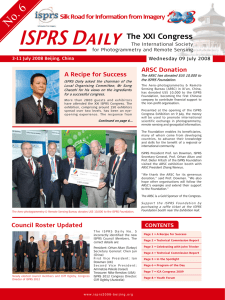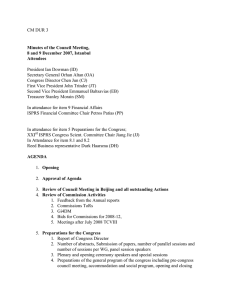Document 11823428
advertisement
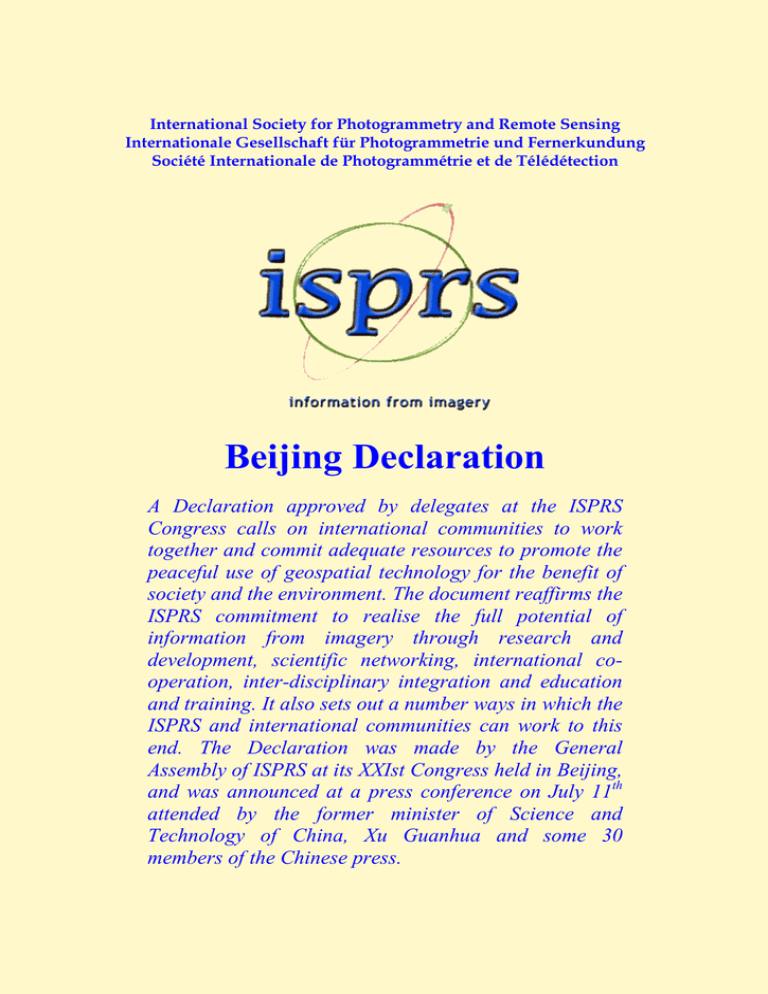
International Society for Photogrammetry and Remote Sensing Internationale Gesellschaft für Photogrammetrie und Fernerkundung Société Internationale de Photogrammétrie et de Télédétection Beijing Declaration A Declaration approved by delegates at the ISPRS Congress calls on international communities to work together and commit adequate resources to promote the peaceful use of geospatial technology for the benefit of society and the environment. The document reaffirms the ISPRS commitment to realise the full potential of information from imagery through research and development, scientific networking, international cooperation, inter-disciplinary integration and education and training. It also sets out a number ways in which the ISPRS and international communities can work to this end. The Declaration was made by the General Assembly of ISPRS at its XXIst Congress held in Beijing, and was announced at a press conference on July 11th attended by the former minister of Science and Technology of China, Xu Guanhua and some 30 members of the Chinese press. We, members of The International Society for Photogrammetry and Remote Sensing (ISPRS) and participants of the XXIst ISPRS Congress in Beijing, recognize the importance of imagery to measure and monitor the natural and man-made features on planet Earth and to explore other planets of the solar system, especially after witnessing the important role of photogrammetry, remote sensing and spatial information systems in the rescue operation and damage assessment of the recent devastating natural disasters. We note scientific developments reported during the technical sessions of the Congress and the great progress made in the use of imagery from many different platforms, with numerous sensors, for a wide variety of applications. We particularly note: 1. Wide applications of Earth observation technologies and tools to the fields of socio-economic sustainable development, natural disaster prediction, mitigation and response, maintenance of biodiversity, cultural heritage conservation, global and environmental climate change monitoring, energy exploration and management, land use and land cover inventory, food security, sustainable use of water resources, and human habitat, environment and health. 2. Significant technological achievement in the acquisition, processing, interpretation and analysis of aerial and satellite imagery, advances of airborne and terrestrial lidar, development of imaging radar technology, increased maturity of small satellites and of geo-sensor networks, validation, calibration and certification of digital cameras and other types of sensors, automated information extraction from all forms of imagery, distributed data processing for information services, and multidimensional data modeling. 3. Great progress in developing new forms of cooperation and knowledge sharing, including the Group on Earth Observation (GEO) and its program to establish a Global Earth Observation System of Systems (GEOSS), and the International Council for Science (ICSU) Geo-unions and its activities in Africa, and the Joint Board of Geospatial Information Societies. Recalling that the 2002 World Summit for Sustainable Development (WSSD) stressed the importance of Earth observation for advancing sustainable development, we strongly believe that photogrammetry, remote sensing and spatial information sciences are essential to ensure sustainable development in the 21st century. We further recognize that non-governmental organizations, especially ISPRS, have the responsibility to promote the peaceful use of space, airborne and terrestrial technology and the realization of the full potential of imagery for the benefit of society and for the maintenance of sustainable growth in all nations. We reaffirm our commitment to implement the vision for the 21st century of ISPRS, which aims to realize the full potential of information from imagery by encouraging and facilitating research and development, advancing knowledge by scientific networking, promoting international cooperation, pursuing inter-disciplinary integration, facilitating education and training, enhancing and exploring new applications, developing public recognition of photogrammetry, remote sensing and the spatial information sciences. We therefore call on international communities to support the Cape Town declaration of GEO and: 1. to commit adequate investment and active engagement in scientific research and development, education and training, and capacity and infrastructure building; 2. to promote the sharing of imaging and ranging technology and data for scientific research and peaceful applications; and 3. to encourage constructive dialogue and close cooperation and collaboration between scientists, governments, public and private sectors, nongovernmental organizations, and international organizations and institutions. We further call for a contribution from everyone to establish and operate a new silk road for information from imagery, leading to a people-centered and sustainable development-oriented information society. Song Chaozhi, Deputy Director General of SBSM; Ian DOWMAN, President of ISPRS; XU Guanhua, former Minister of Science and Technology of Peoples Republic of China; Orhan ALTAN, Secretary General of ISPRS; Chen Jun, Congress Director of Beijing Congress The principles embodied in the Beijing Declaration are endorsed by: Asian Association on Remote Sensing Global Spatial Data Infrastructure Association International Astronomical Union International Federation of Surveyors International Geographical Union International Hydrographic Organization International Map Trade Association International Steering Committee for Global Mapping International Union of Geodesy and Geophysics International Union of Geological Science International Union for Quaternary Research International Union of Radio Science International Union of Soil Sciences International Year of Planet Earth


